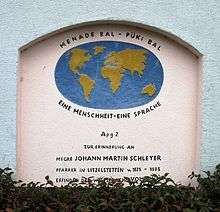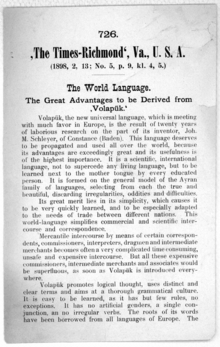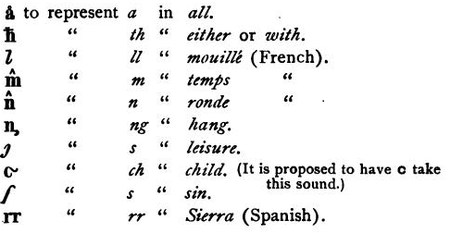Volapük
| Volapük | |
|---|---|
|
Logo of the Volapük movement (2nd phase) | |
| Created by | Johann Martin Schleyer |
| Date | 1879–1880 |
| Setting and usage | International: mostly in Europe |
| Users | 20 (2000)[1] |
| Purpose | |
| Latin | |
| Sources | vocabulary from English, German, and French |
| Official status | |
| Regulated by | Kadäm Volapüka |
| Language codes | |
| ISO 639-1 |
vo |
| ISO 639-2 |
vol |
| ISO 639-3 |
vol |
| Glottolog | None |
Volapük (/ˈvɒləpʊk/ in English;[2] [volaˈpyk] in Volapük) is a constructed language, created in 1879–1880 by Johann Martin Schleyer, a Roman Catholic priest in Baden, Germany. Schleyer felt that God had told him in a dream to create an international language. Volapük conventions took place in 1884 (Friedrichshafen), 1887 (Munich) and 1889 (Paris). The first two conventions used German, and the last conference used only Volapük. In 1889, there were an estimated 283 clubs, 25 periodicals in or about Volapük, and 316 textbooks in 25 languages;[3] at that time the language claimed nearly a million adherents.[4] Volapük was largely displaced in the late 19th and early 20th centuries by Esperanto.[5]
History

Eine Menschheit – eine Sprache
(One mankind – one language)
Schleyer first published a sketch of Volapük in May 1879 in Sionsharfe, a Catholic poetry magazine of which he was editor. This was followed in 1880 by a full-length book in German. Schleyer himself did not write books on Volapük in other languages, but other authors soon did.
André Cherpillod writes of the third Volapük convention,
In August 1889 the third convention was held in Paris. About two hundred people from many countries attended. And, unlike in the first two conventions, people spoke only Volapük. For the first time in the history of mankind, sixteen years before the Boulogne convention, an international convention spoke an international language.[6]
The Dutch cryptographer Auguste Kerckhoffs was for a number of years Director of the Academy of Volapük, and introduced the movement to several countries. However, tensions arose between Kerckhoffs and others in the Academy, who wanted reforms made to the language, and Schleyer, who insisted strongly on retaining his proprietary rights. This led to schism, with much of the Academy abandoning Schleyer's Volapük in favor of Idiom Neutral and other new constructed language projects. Another reason for the decline of Volapük may have been the rise of Esperanto. In 1887 the first Esperanto book (Unua Libro) was published. Many Volapük clubs became Esperanto clubs.
By 1890 the movement was in disarray, with violent arguments among the members. Schleyer resigned from the Volapük Academy and created a rival academy. Derived languages such as Nal Bino, Balta, Bopal, Spelin, Dil and Orba were invented and quickly forgotten.[7][8] By 1900 there were only 159 members of Volapük clubs recognized by Schleyer.[6] The umlauts, which may have been one of the reasons for the language's eventual decline into obscurity, were the subject of ridicule. For example, the Milwaukee Sentinel published the limerick:[8]
- A charming young student of Grük
- Once tried to acquire Volapük
- But it sounded so bad
- That her friends called her mad,
- And she quit it in less than a wük.

In the 1920s, Arie de Jong, with the consent of the leaders of the small remnant of Volapük speakers, made a revision of Volapük which was published in 1931 (now called Volapük Nulik "New Volapük" as opposed to the Volapük Rigik 'Original Volapük' of Schleyer). This revision was accepted by the few speakers of the language. De Jong simplified the grammar, eliminating some rarely used verb forms, and eliminated some gendered pronouns and gendered verb endings. He also rehabilitated the phoneme /r/ and used it to make some morphemes more recognizable. For instance, lömib "rain" became rein.[9] Volapük enjoyed a brief renewal of popularity in the Netherlands and Germany under de Jong's leadership, but was suppressed (along with other constructed languages) in countries under Nazi rule and never recovered.
Regarding the success of this artificial language, the Spanish scientist Santiago Ramón y Cajal wrote in the first edition of his Tonics of Willingness, in 1898:
"Nowadays, many scientific papers are published in more than six languages. To the likely attempt of restoring Latin or using Esperanto as the universal language of science, wise men have responded by multiplying the number of languages in which scientific works are published. We have to acknowledge that Volapük or Esperanto are practically one more language to be learnt. This result was predictable because neither the essentially popularized and democratic tendencies of modern knowledge, nor the economic views of authors and editors consent in a different way."[10]
However, some years later (1920), in the third edition of the same book, he added the following footnote to the former assertion: "As it was presumable, nowadays -1920-, the brand new Volapük has been forgotten definitively. We forecast the same for Esperanto."
Large Volapük collections are held by the International Esperanto Museum [11] in Vienna, Austria; the Centre de documentation et d'étude sur la langue internationale in La Chaux-de-Fonds, Switzerland; and the American Philosophical Society in Philadelphia, Pennsylvania.[12] In 2000 there were an estimated 20 Volapük speakers in the world.[1]
In December 2007 it was reported that the Volapük version of Wikipedia had recently jumped to 15th place among language editions, with more than 112,000 articles. [13] A few months earlier there had been only 797 articles. The massive increase in the size of "Vükiped", bringing it ahead of the Esperanto Wikipedia, was due to an enthusiast who had used a computer program to automatically create geographical articles, many on small villages. The motive was to gain visibility for the language.[14] By March 2013 the Esperanto Wikipedia, with a very active user community, had risen to 176,792 articles, while the Volapük Wikipedia had at that point 119,091 articles.[15]
There has been a continuous Volapük speaker community since Schleyer's time, with an unbroken succession of Cifals (leaders). These were:
- Johann Martin Schleyer 1879–1912
- Albert Sleumer 1912–1948
- Arie de Jong (provisionally) 1947–1948,[16] 1951–1957[17]
- Jakob Sprenger 1948–1950
- Johann Schmidt 1950–1977
- Johann Krüger 1977–1983
- Brian Bishop 1984–2014
- Hermann Philipps 2014–present[18][19]
Orthography and pronunciation

The alphabet is as follows:[20][21][22]
|
|
|
|
That is, the vowel letters ä, ö, ü have the pronunciations they do in German. C is pronounced like English j, and j like English sh. /s/ is pronounced [z] after voiced consonants, for example bs, ds, gs, ls, as it is in English. R and W were not found in the original proposal.
Note: The letters ä, ö, and ü do not have alternative forms such as the ae, oe, and ue of German, but Schleyer proposed alternate forms ꞛ, ꞝ, and ꞟ for them, all of which are part of Unicode since version 7.0 released in June 2014.[23]
There are no diphthongs; each vowel letter is pronounced separately.
Special consonantal letters
The author Alfred A. Post mentions in his Comprehensive Volapük Grammar some additional letters created by Schleyer:
- And the following letters are constructed by the inventor to designate sounds which occasionally occur –

Letter r
The letter r was avoided in Schleyer's original Volapük, on the principle that it would be difficult for Chinese speakers to pronounce, and in the adoption of foreign roots r was generally changed to l.[7] For example, English rose becomes lose. However, other uncommon phonemes, such as ö /ø/ and ü /y/, were not avoided,[24] and Arie de Jong added /r/ in his 1929 revision of the language. Modern Volapük has minimal l–r pairs such as rel "religion" versus lel "iron".
Syllabic stress
Polysyllabic words are always stressed on the final vowel; for example, neai "never" is pronounced [ne.a.ˈi]. (However, the question clitic "-li" does not affect the stress of the word it attaches to.) Where there is secondary stress, as is found in the compounding of several roots together, it is found on the final syllable between the roots.
Vocabulary
Schleyer adapted the vocabulary mostly from English, with a smattering of German and French. Some words remain readily recognizable for a speaker of one of the source languages, but many others are modified beyond easy recognition.[25] For instance, vol and pük are derived from the English words world and speak. Although unimportant linguistically, and regardless of the simplicity and consistency of the stress rule, these deformations were greatly mocked by the language's detractors. It seems to have been Schleyer's intention, however, to alter its loan words in such a way that they would be hard to recognise, thus losing their ties to the languages (and, by extension, nations) they came from. Conversely, Esperanto and Interlingua are commonly criticized as being much easier to learn for Europeans than for those with non-European native languages.
Grammar
The grammar is based on that of typical European languages, but with an agglutinative character: grammatical inflections are indicated by stringing together separate affixes for each element of meaning.
Nouns
Nouns inflect for case and number, but not for gender.
The following is the declension of the Volapük word vol "world":
| Case | Singular | Plural |
|---|---|---|
| Nominative | vol (world) | vols (worlds) |
| Genitive | vola (of the world) | volas (of the worlds) |
| Dative | vole (to the world) | voles (to the worlds) |
| Accusative | voli (world) | volis (worlds) |
As in German, the Volapük noun has four cases: nominative, genitive, dative and accusative. In compound words, the first part of the compound is usually separated from the second by the genitive termination -a, e.g. Vola-pük, "of-world language". However, the other case endings (-e dative, -i accusative) are sometimes used, or the roots may be agglutinated in the nominative, with no separating vowel.
Adjectives and adverbs
Adjectives, formed by the suffix -ik, normally follow the noun they qualify. They do not agree with the noun in number and case in that position, but do if they precede the noun, are separated from it by intervening words, or stand alone. Adverbs are formed by suffixing -o, either to the root or to the adjectival -ik (gudik "good", gudiko "well"); they normally follow the verb or adjective they modify.
Pronouns
The pronouns begin with o-. In the singular, they are ob "I", ol "thou", om "he/it", of "she", os (impersonal),[26] on "one", ok "oneself". They are pluralized with -s: obs "we", oms "they". The possessive may be formed with either the genitive -a or with adjectival -ik: oba or obik "my". Prepositions, conjunctions and interjections are also formed from noun roots by appending appropriate suffixes.
Verbs
The verb carries a fine degree of detail, with morphemes marking tense, aspect, voice, person, number and (in the third person) the subject's gender. However, many of these categories are optional, and a verb can stand in an unmarked state. A Volapük verb can be conjugated in 1,584 ways (including infinitives and reflexives).[27]
- Person
For the simple present, the pronouns are suffixed to the verb stem:
- binob I am, binol thou art,
etc. The present passive takes the prefix pa-:
- palöfons they are loved.
- Tense, aspect, and voice
The three tenses in the indicative, and the three perfect aspects, each take a characteristic vowel prefix:
| Tense | Prefix |
|---|---|
| Present | a- |
| Past | ä- |
| Present perfect | e- |
| Past perfect | i- |
| Future | o- |
| Future perfect | u- |
The present-tense prefix is omitted in the active voice, so:
- binob I am, äbinol you were, ebinom he has been, ibinof she had been, obinos it will be, ubinon one will have been.
These are seen as being more distant from the present tense the further the vowel is from [a] in vowel space, and they can be used with temporal words to indicate distance in the past or future. For example, from del 'day',
- adelo today, odelo tomorrow, udelo the day after tomorrow, ädelo yesterday, edelo the day before yesterday, idelo three days ago.
The passive voice is formed with p-, and here the a is required for the present tense:
- palöfob I am loved, pälogol you were seen, pologobs we will be seen.
- Infinitive mood
The infinitive is formed with the suffix -ön. It can be combined with tense/aspect prefixes:
- Logön to see, elogön to have seen.
- Interrogative mood
Yes–no questions are indicated with the particle li:
- Pälogom-li was he seen?
The hyphen indicates that the syllable li does not take stress. It occurs before the verb to avoid a sequence of three consonants or a double el: li-pälogol? li-binoms?
- Participles and the habitual aspect
Participles, both active and passive, are formed in -öl:
- Logöl seeing, elogöl having seen, ologöl being about to see, palogöl seen (being seen), pelogöl seen (having been seen), pologöl about to be seen.
Binob penöl is literally 'I am writing', though penob is also used. For "I write" as habitual action, the habitual aspect is used. This is formed by adding -i- after the tense prefix, and here again the present-tense a- is required. The forms are thus active ai-, äi-, ei-, ii-, oi-, ui-, passive pai-, päi-, pei-, pii-, poi-, pui-. All are pronounced as two syllables.
- Aifidob bodi I eat bread (as a daily occurrence), äipenob penedis I used to write letters.
With temporal words,
- aidelo daily (at the present time)
- The imperative moods
The imperative -öd follows the person suffix:
- Gololöd! Go! (to one person), gololsöd! go! (to more than one person)
Optative -ös is used for courteous requests, and jussive -öz an emphatic command.
- Conditional mood
Conditionals are formed with -la for the protasis (if-clause) and -öv for the apodosis (then-clause):
- If äbinob-la liegik, äbinoböv givik – if I were rich I would be generous.
- Ibinomöv givik, if ibinom-la liegik – he would have been generous if he had been rich.
Note that the tense changes as well, so that in the first example the past tense is used even though the present tense is intended. Like the question particle, the -la is written with a hyphen to indicate that it is not stressed in speech.
- Potential mood
A potential mood is formed with -öx:
- Pelomöx he might pay.
- Reflexive verbs
Reflexive forms are made from the active voice and the pronoun ok:
- Vatükob I wash, vatükobok (or vatükob obi) I wash myself.
In the third person, the periphrastic form of vatükomok (he washes himself) must use the reflexive pronoun, vatükom oki, as vatükom omi would mean "he washes him (someone else)".
The plural -s may precede or follow the reflexive, as the speaker chooses:
- vatükomoks or vatükomsok they wash themselves.
Here there is a meaningful distinction between joining the pronoun to the verb, and inflecting it independently:
- Löfobsok we love ourselves, löfobs obis we love each other.
- Gerundive
The gerundive arguments are active ö-, passive pö-.
Examples
The Lord's Prayer
| 1880 Schleyer Volapük | 1930 de Jong Volapük |
|---|---|
| O Fat obas, kel binol in süls, | O Fat obas, kel binol in süls! |
| paisaludomöz nem ola! | Nem olik pasalüdükonöd! |
| Kömomöd monargän ola! | Regän ola kömonöd! |
| Jenomöz vil olik, äs in sül, i su tal! | Vil olik jenonöd, äsä in sül, i su tal! |
| Bodi obsik vädeliki givolös obes adelo! | Givolös obes adelo bodi aldelik obsik! |
| E pardolös obes debis obsik, | E pardolös obes döbotis obsik, |
| äs id obs aipardobs debeles obas. | äsä i obs pardobs utanes, kels edöbons kol obs. |
| E no obis nindukolös in tendadi; | E no blufodolös obis, |
| sod aidalivolös obis de bad. | ab livükolös obis de bad! |
| (Ibä dutons lü ol regän, e nämäd e glor jü ün laidüp.) | |
| Jenosöd! | So binosös! |
Sample text
Ven lärnoy püki votik, vödastok plösenon fikulis. Mutoy ai dönu sukön vödis nesevädik, e seko nited paperon. In dil donatida, ye, säkäd at pebemaston, bi tradut tefik vöda alik pubon dis vöds Volapükik. Välot reidedas sökon, e pamobos, das vöds Volapükik pareidons laodiko. Gramat e stabavöds ya pedunons in nüdug; too loged viföfik traduta pakomandos ad garanön, das sinif valodik pegeton. Binos prinsip sagatik, kel sagon, das stud nemödik a del binos gudikum, ka stud mödik süpo.
Translation: When one is learning another language, vocabulary presents difficulties. One must continuously search for unknown words, and consequently interest is lost. In the elementary part, however, this problem has been overcome, because the relevant translation of each word appears below the Volapük words. A selection of readings follows, and it is suggested that the Volapük words be read out loud. The grammar and a basic vocabulary have already been done in the introduction; nevertheless, a quick glance at the translation is recommended to ensure that the overall meaning has been acquired. There is a maxim which states that a little study a day is better than a lot of study all at once.
Usage as common noun
The word Volapük is also used to mean "nonsense" and "gibberish" in certain languages, such as Danish[28] in the expression Det er det rene volapyk for mig ("It's pure Volapük to me"). In Esperanto, "volapukaĵo" is also a slang term for "nonsense", and the expression Tio estas volapukaĵo al mi ("That's a Volapük-ation to me") is sometimes used like the English "it's Greek to me" (that is, "I can't understand this" or "this is nonsense").[29]
See also
| Volapük edition of Wikipedia, the free encyclopedia |
- Volapuk encoding
- Wikipedia:Volapük Wikipedia
References
- 1 2 "Pük, Memory: Why I Learned a Universal Language No One Speaks" by Paul LaFarge. The Village Voice, August 2000.
- ↑ OED
- ↑ Handbook of Volapük, Charles E. Sprague (1888)
- ↑ A History of the English Language, 5th ed. Albert C. Baugh and Thomas Cable. Ch. I English Present and Future; Prentice Hall, Upper Saddle River (2002)
- ↑ The Loom of Language F. Bodmer and L. Hogben (eds.) Ch. XI Pioneers of Language Planning; Allen & Unwin Ltd, London (1944)
- 1 2 Foreword to Konciza Gramatiko de Volapuko, André Cherpillod. Courgenard, 1995.
- 1 2 Pei, Mario (1968). One Language for the World. New York: Biblo and Tannen. p. 134. Retrieved 29 April 2015.
- 1 2 Arika Okrent (December 15, 2012). "Trüth, Beaüty and Volapük". berfrois. Retrieved 2013-04-24.
- ↑ Arie de Jong's Revision of Volapük (1931) by Ed Robertson
- ↑ Ramón y Cajal, S. (2009): Tonics of Willingness: Rules and Advices about Scientific Investigation. Formación Alcalá: Alcalá la Real, Jaén.
- ↑ Collection for Planned Languages (in German)
- ↑ Volapük Collection - American Philosophical Society
- ↑ "Ciekawe wydarzenia w Internecie". PC World (Polish) (in Polish). December 1, 2007. Retrieved 2013-04-26.
- ↑ Yves Nevelsteen (2007-09-15). "Volapuko jam superas Esperanton en Vikipedio". Libera Folio (in Esperanto). Retrieved 2013-04-26.
- ↑ R.L.G. (7 March 2013). "The keenest Wikipedians". The Economist. Retrieved 2013-04-26.
- ↑ http://www.volapük.com/kadam/Dalebud_Cifala_de_1947-01-15,_Num-_1.html
- ↑ http://www.volapük.com/kadam/Dalebud_Cifala_de_1950-12-21,_Num-_4.html
- ↑ "Yahoo! Groups". yahoo.com.
- ↑ "Volapuko havas novan Cifal!", La Balta Ondo, May 29, 2014.
- ↑ Sprague (1888)
- ↑ "A Quick Look at Volapük". Volapük.com. Volapük.com. Retrieved 2015-11-12.
- ↑ Ager, Simon. "Volapük alphabet". Omniglot. Kualo. Retrieved 2014-08-31.
- ↑ "Latin Extended-D Range: A720–A7FF" (PDF). Unicode.org. June 2014. Retrieved 4 May 2015.
- ↑ Front rounded vowels such as slink and /ø/ occur in only 7.10% of the languages in the UCLA Phonological Segment Inventory Database.
- ↑ "For example, while it is true that words like vol and pük don't really look like world and speak, but the whole language is not like that. Scores of words are very obvious as what they mean – if, fasilik, gudik/badik, smalik, jerik (pronounced sherík – expensive), bank, bäk (back), deadik". – "What the L!", AUXLANG list posting by Thomas Alexander, 15 November 2005.
- ↑ Os is used for cases where the pronoun has no obvious antecedent, such as "I swear it", and perhaps with impersonal verbs. Om is used for abstract things such as lit "light".
- ↑ Rogers, Stephen D. (2011). A Dictionary of Made-Up Languages: From Adunaic to Elvish, Zaum to Klingon-- the Anwa (Real) Origins of Invented Lexicons. Avon: Adams Media Corporation. p. 238. ISBN 978-1440528170.
- ↑ "The Hardest Natural Languages" by Arnold L. Rosenberg (1979)
- ↑ Burger, Harald, et al. Phraseologie. ISBN 978-3-11-019076-2.
External links
| Volapük repository of Wikisource, the free library |
Portal
Summaries
- Blueprints for Babel: Volapük – A summary of the grammar of Volapük
- Chapter on Volapük in Otto Jespersen's pro Novial An International Language (1928)
- Article on Volapük from the 1911 Encyclopaedia Britannica
- Philipp Engert und Leonard Schwägerl (Hrsg.): Schleyer und Volapük—Geschichte und Linguistik. Seminarkurs 2012/2013 Martin-Schleyer-Gymnasium, Lauda-Königshofen. Verlag tredition GmbH Hamburg 2013; ISBN 978-3-8495-7238-9
The original Volapük
- Charles Sprague, 1888, Hand-Book of Volapük
The 1931 revised Volapük
- Summary of "Arie de Jong's Revision of Volapük (1931)" by Ed Robertson. From the 21st edition of the Journal of Planned Languages, 1995.
Tutorials
- A ten-lesson course in modern Volapük
- Ralph Midgley's web-page
- A complete Italian grammar of Schleyer's original Volapük
Handbooks, grammars and dictionaries
- Gramat Volapüka - by Arie de Jong – Volapük Nulik
- Wörterbuch der Weltsprache: Vödabuk Volapüka - by Arie de Jong – Volapük Nulik
- English–Volapük dictionary – Compiled by Ralph Midgley (1998) – Volapük Nulik
- Malgranda gramatiko de Volapuko per Esperanto by the ex-Cifal Brian Bishop (2015) - Volapük Nulik
- Vocabulary – Volapük Rigik
- A complete Italian grammar of Volapük (1888) by V. Amoretti – Volapük Rigik
- A Hand-book of Volapük, by Andrew Drummond – comic historical novel. ISBN 1-904598-67-6 – Volapük Rigik
Volapük links and bibliographies
Discussions
- Volapükalised – A Volapük group on Yahoo!, general discussion in Volapük about any topic and about Volapük in various other languages
- Volapük Facebook Group
- IRC chat channel in Volapük
- Blog in Volapük
